Carbon Capture, Utilisation, and Storage (CCUS) has emerged as a beacon of hope in the global battle against climate change. This intricate technology offers a multifaceted approach to mitigate carbon dioxide (CO2) emissions, providing solutions to industries considered “hard-to-abate” while paving the way for a sustainable energy future. In this comprehensive exploration, we unravel the intricate layers of CCUS, examining its potential, current developments, and the challenges it must overcome.

What is CCUS?
In its simplest form, CCUS encompasses a series of methods designed to prevent carbon dioxide from entering the atmosphere or to remove it once it is there. However, beneath this simplicity lies a sophisticated array of technologies with the potential to revolutionise how we address climate change.
In most cases, CCUS refers to a site of technologies that mitigate CO2 emissions from significant point sources like power plants, refineries, and industrial facilities. These sources, often associated with the combustion of fossil fuels or industrial processes such as cement and steel production, release carbon dioxide into the atmosphere alongside other gases. The diverse range of capture technologies employed in CCUS extracts these produced CO2 in concentrated form, paving the way for storage or utilisation.
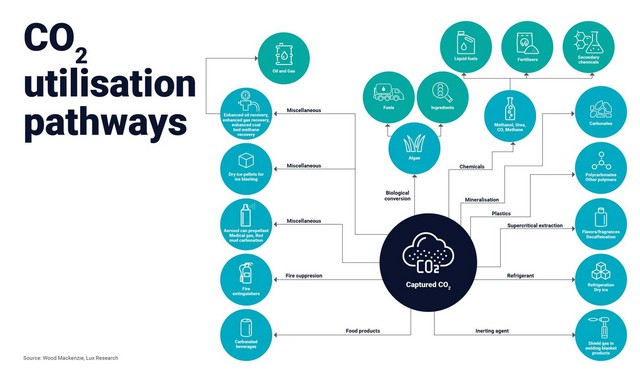
CCUS operates through two primary approaches: Carbon Capture and Storage (CCS) and Carbon Capture and Utilisation (CCU). In CCS, captured CO2 is transported to underground storage sites, typically through pipelines or ships, and injected into suitable reservoirs such as deep saline aquifers or depleted oil and gas fields. On the other hand, CCU involves putting the captured CO2 to use, either by incorporating it into permanent products (e.g., construction materials) or by employing it in processes like Enhanced Oil Recovery (EOR).
Amid global efforts to reduce emissions in the energy industry, CCUS technology has gained prominence. Recognised by leading organisations s, including the International Energy Agency (IEA), International Renewable Energy Agency (IRENA), Intergovernmental Panel on Climate Change (IPCC), and Bloomberg New Energy Finance (BNEF), CCUS plays a pivotal role in meeting ambitious climate targets to limit global temperature rise to 1.5°C.
The Mechanics of CCUS — How It Works
CCUS application is a meticulous three-stage process involving the capture, transport, and storage (or usage) of CO2. Various methods are employed for capturing CO2, with post-combustion, pre-combustion, and oxy-fuel combustion leading the way.
Post-combustion technology involves separating CO2 from flue gas, typically using a chemical solvent after burning the fuel. On the other hand, pre-combustion methods convert fuel into a gas mixture of hydrogen and CO2 before burning, with the remaining hydrogen-rich mixture serving as fuel. Oxy-fuel technology involves burning fuel with nearly pure oxygen, producing CO2 and steam, which are then captured.

The versatility of CCUS technology allows for retrofitting existing facilities or incorporating it into new plants. While post-combustion and oxy-fuel equipment can be applied to new and existing facilities, pre-combustion methods need more significant modifications, making them more suitable for new plant developments to implement the technology as part of the design.
An intriguing aspect of CCUS is the Direct Air Capture (DAC) option, wherein CO2 is extracted directly from the atmosphere. This method, involving fans and solid sorbents or liquid solvents, is energy-intensive and more expensive due to the lower concentration of CO2 in the atmosphere compared to flue gas.
Once captured, CO2 is compressed into a liquid state and transported through various means, including pipelines, ships, rail, or road tankers. The injection of CO2 into deep geological formations, such as depleted oil and gas reservoirs, coal beds, or deep saline aquifers, allows for permanent storage. Global evidence suggests that available underground storage exceeds what is required to meet climate targets, with many high-emitting nations boasting substantial storage resources.

Beyond permanent storage, CCU introduces an alternative pathway. Here, captured CO2 becomes an input for commercial products and services, from construction materials to synthetic fuels, challenging conventional notions of waste and emissions. However, the climate implications of this alternative require careful examination, underscoring the need for a balanced and thoughtful approach.
Potential of CCUS for Tackling Climate Change
CCUS stands as a linchpin in global decarbonisation efforts, offering strategic solutions that complement and, in some cases, surpass the reach of renewables:
- Tackling Hard-to-Abate Industries:
CCUS plays a crucial role in addressing emissions from industries that are challenging to decarbonise using renewable energy alone. These industries, such as cement, chemicals, and steel, contribute about a quarter of global greenhouse gas emissions. CCUS provides a practical and cost-effective solution to cut emissions in processes requiring intense heat, often derived from fossil fuels.
- Power Supporter for Low-Carbon Electricity:
In the future, renewable energy sources like solar and wind are expected to dominate electricity generation. However, these sources are weather-dependent, requiring backup power solutions. CCUS can ensure a stable supply of low-carbon electricity by supporting natural gas, acting as a reliable backup for intermittent renewable sources.
- Hydrogen Launcher:
Hydrogen is recognised as a key element in achieving a net-zero world, especially for industries and transport. While the primary focus is on producing hydrogen using surplus renewable energy, CCUS facilitates the transition by enabling the production of blue hydrogen from natural gas. This method helps bridge the gap until green hydrogen becomes more widespread.
- Air Purification and Carbon Removal:
Beyond emission reduction in industrial settings, CCUS contributes to air purification by directly removing carbon dioxide from the atmosphere. This is crucial for achieving net-zero emissions globally. Some carbon removal is necessary to compensate for remaining emissions and historical carbon output to mitigate climate change and reach net zero targets in time.
CCUS is one of the most cost-effective options (and the only known technological option)) for achieving deep decarbonisation in various industries. Its application in sectors like iron, steel, and chemicals, integral to modern economies, emphasises its role in driving meaningful emissions cuts. As governments and industries worldwide strive for sustainable practices, CCUS stands out as a practical and economically viable solution to the complexities of achieving deep emissions reductions.
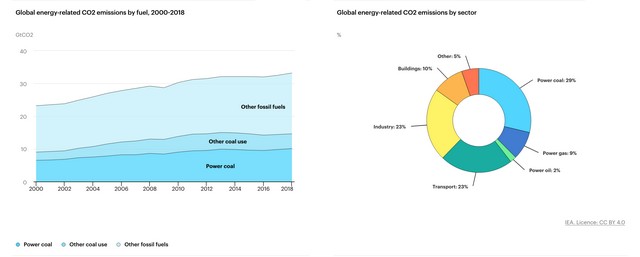
As some industries likewise explore alternatives to CCUS, low-carbon hydrogen emerges as a formidable contender. Green hydrogen, produced by splitting water using renewable power, offers a sustainable option compared to burning fossil fuels to produce backup power, steelmaking, and high-temperature industrial processes. While currently expensive and facing scalability challenges, CCUS could act as a catalyst for the growth of the hydrogen economy, mainly through blue hydrogen made from natural gas with CCUS. This approach scales up the clean hydrogen market and lays the groundwork for broader adoption of green hydrogen in the future.
Global Landscape of CCUS Development
As the world grapples with the urgent need for sustainable solutions to climate change, CCUS technology and development have gained significant momentum since the start of 2018. This surge is propelled by strengthened climate targets and increased global policy support, resulting in over 500 projects in various stages of development across the CCUS value chain. The geographical distribution of CCUS projects is diversifying, with projects now in progress in more than 45 countries.
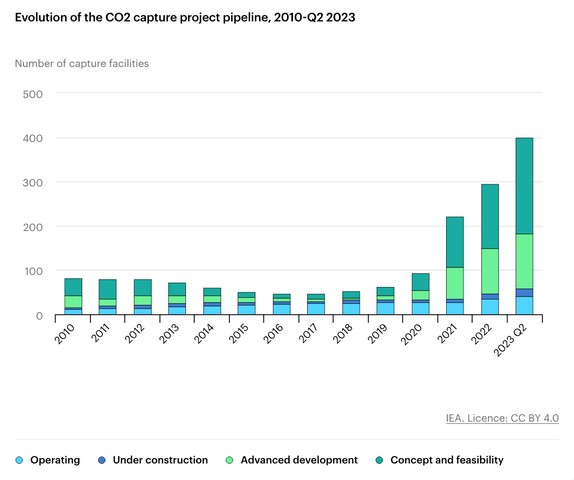
Several countries and regions have made substantial strides in CCUS development, showcasing diverse approaches and commitment. The United States has unveiled significant opportunities, including funding under the 2021 Infrastructure Investment and Jobs Act and and favourable CCUS tax credit changes in the 2022 Inflation Reduction Act, while the European Union has proposed a CO2 storage target. Indonesia has set the stage by finalising its legal and regulatory framework for CCUS, becoming the first country in the region to establish such a foundation. Notable progress has also been made in the Asia-Pacific region, where countries like China, Malaysia, Singapore, and Thailand have announced projects. The Middle East, too, has seen advancements, with projects in development in addition to those already in operation.
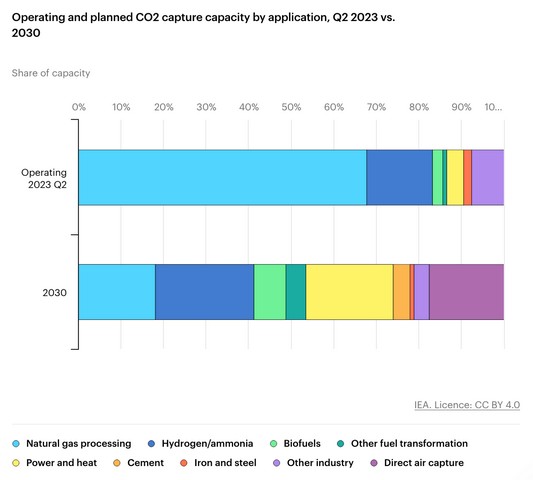
CCUS deployment has substantially increased in recent years, with over 40 commercial facilities operating worldwide. These facilities, applying CCUS to industrial processes, fuel transformation, and power generation, boast a total annual capture capacity exceeding 45 Mt CO2. Ambitious plans have been unveiled, indicating the establishment of around 50 new capture facilities by 2030, capturing approximately 125 Mt CO2 per year.
Technological innovations continue to reshape the landscape of CCUS, with an increasing focus on reducing costs for power generation. Projects like NET Power’s 50 MW clean energy plant, utilising the Allam cycle technology, and the Net Zero Teesside Power in the United Kingdom, expected to come online in 2027, showcase the industry’s commitment to innovation and commercial-scale implementation.

Some of the more notable developments include seven new large-scale capture facilities, with capacities exceeding 100,000 tCO2/yr, have recently come online, showcasing the global expansion of CCUS. Projects such as the Red Trail Energy Project in the United States, the Arcelor LanzaTech Carbalyst (Steelanol) project in Belgium, and initiatives in China, including the Sinopec Qilu Petrochemical Shengli facility and the CNOOC Enping oil field, underscore the international commitment to CCUS.
In addition to CCUS infrastructure, governments worldwide actively support CCUS through funding and regulatory frameworks. The United States and the United Kingdom have allocated substantial funds for CCUS projects, while the European Union has introduced the Net Zero Industry Act. Canada has proposed an expansion of its investment tax credit, and Indonesia has established a comprehensive legal and regulatory framework for effective CCUS stewardship.

Despite the evident progress, CCUS deployment remains below the levels required to achieve the Net Zero Emissions by 2050 (NZE) Scenario. Only around 20 commercial capture projects under development have reached a final investment decision as of June 2023. In response, nations such as the United States, the United Kingdom, and the European Union are increasing funding for CCUS projects to stimulate further investment.
CCUS in ASEAN
CCUS stands at the forefront of ASEAN’s clean energy transition, with approximately a dozen projects in various stages across member states. This collective effort extends beyond individual nations to regional collaboration. For instance, a group of ten Southeast Asian countries is actively exploring cross-border carbon transport and storage and developing regional carbon markets to make CCUS projects economically and technically feasible in the region.
Despite a commitment to reduce carbon emissions, ASEAN energy ministers expressed the necessity for some countries to continue reliance on coal-based power to meet the people’s energy needs during a meeting in Bali in August 2023. This reality underscores the importance of establishing a comprehensive CCUS deployment framework and roadmap towards decarbonising hard-to-abate industries such as cement, chemicals, and steel, allowing countries to comply with international commitments while minimising social and economic disruptions. As countries strive for carbon neutrality by 2050 or 2060, CCUS solutions emerge as pivotal in decarbonising the remaining coal and natural gas operations.
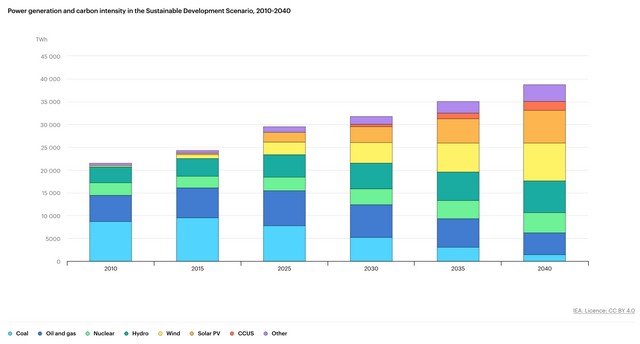
Despite a commitment to reduce carbon emissions, ASEAN energy ministers expressed the necessity for some countries to continue reliance on coal-based power to reliably meet their people’s energy needs. This underscores the importance of establishing a comprehensive CCUS deployment framework and roadmap towards decarbonising hard-to-abate industries such as cement, chemicals, and steel, allowing countries to comply with international commitments while minimising social and economic disruptions. As countries strive for carbon neutrality by 2050 or 2060, CCUS solutions emerge as pivotal in decarbonising the remaining coal and natural gas operations.
Malaysia’s commitment to carbon reduction is ingrained in its National Energy Transition Roadmap, which outlines plans for three CCUS hubs—two in Peninsular Malaysia and one in Sarawak. The nation has set ambitious targets, pledging to reduce CO2 emissions per unit of GDP by 45% from 2005 levels by 2030. To support its goal of becoming a carbon-neutral nation by 2050, Malaysia is exploring economic instruments such as carbon pricing and a carbon tax. Moreover, the Malaysian government is committed to cease the construction of new coal-fired power plants.
Under the National Energy Policy 2022-2040, CCUS is explicitly mentioned as a technology to drive efficiency in operations, particularly in the oil and gas sector. Malaysia’s national oil and gas company, PETRONAS, is at the forefront of CCUS technology, employing Carbon Capture and Storage (CCS) technology in high CO2 fields. Collaborations, such as the one between Tenaga Nasional Berhad (TNB) and PETRONAS, underscore the industry’s commitment to driving innovative solutions toward decarbonisation.

The Malaysian government has introduced a tax incentive scheme for carbon capture and storage in 2023. This initiative aims to limit CO2 emissions using CCS technologies, aligning with Malaysia’s Low Carbon Nation Aspiration by 2040. The scheme includes mechanisms for companies undertaking in-house CCS activity and those providing CCS services, offering various incentives to encourage widespread adoption.
CCUS in Sarawak: A Beacon of Innovation and Sustainable Practices
Sarawak, expressing its commitment to the Paris Agreement, recognises the pivotal role of CCUS technology in achieving a net-zero emission future. Collaborations with international entities, such as POSCO Holdings and Japan’s Inpex, signify Sarawak’s dedication to carbon capture and storage projects.
Petros, the state-owned oil company, received its first license as a resource manager for Sarawak’s natural CCUS resources in March 2023. Similarly, establishing the Chitose Carbon Capture Central Sarawak (C4 Sarawak) in May 2023 marked a significant milestone. Positioned as the world’s most extensive microalgae cultivation and production facility, C4 Sarawak utilises carbon dioxide from the linked coal plant to reduce emissions while cultivating microalgae biomass for biofuel production, thus contributing to Sarawak’s decarbonisation targets and Green Energy Agenda.
Sarawak’s commitment to CCUS extends beyond projects; legislative efforts, such as the Environment (Reduction of Greenhouse Gas Emission) Bill, 2023, exemplify the state’s dedication to sustainable practices. The issuance of licenses for carbon trading further positions Sarawak as a hub for carbon storage and trading activities. The recent agreement signed in February 2024 between Petroleum Sarawak Bhd (Petros) and a Japanese consortium marks a crucial step in feasibility studies for carbon storage sites, emphasising Sarawak’s commitment to advancing CCUS technologies and contributing to a sustainable future.
Challenges and Common Concerns Surrounding CCUS
Despite its immense potential to mitigate the effects of climate change, CCUS has notable challenges.
The primary concern is the high cost of deploying and operating CCUS facilities, making them capital-intensive and energy-consuming. Furthermore, technological uncertainties and the need for continuous advancements add complexity to the equation. Thus, evaluating the cost and risks of CCUS compared to alternative decarbonisation pathways becomes imperative, as limiting its availability could lead to increased reliance on less mature and more expensive technologies.
Another concern raised by technology contestants is their perceived threat to existing energy-intensive industries. While it is true that CCUS facilities carry upfront costs, the wider economic benefits. CCUS enables the continued operation of energy-intensive industries in a net-zero-compliant manner, preventing job losses and asset stranding.
Strong regulations focusing on project selection, management, and ongoing monitoring can mitigate concerns about CO2 leakages from storage sites. Many of the proposed storage sites leverage well-understood geological formations that have stored gas and CO2 naturally for millions of years, minimising overall leakage risks.
Even so, increasing awareness of CCUS does not translate to immediate adoption worldwide. According to the IEA, fossil fuels still dominate global power systems, constituting 64% of power generation. The reliance on coal and gas-fired power plants, particularly in major emerging economies like China and India, poses a significant challenge. The power sector remains a major emitter, contributing nearly 40% of global energy-related emissions, with coal-fired power being the single largest source.
The operational life of existing coal-fired power plants is typically around 50 years, but many are currently only 20 years old. With 2,080 GW of coal-fired capacity worldwide, owners will likely operate these plants for decades. If not transitioned, the existing fossil power fleet risks “locking in” vast CO2 emissions. As such, a profound transformation of electricity demand and supply is required. The Sustainable Development Scenario (SDS) outlined in the IEA World Energy Outlook emphasises decarbonisation, with 85% of global power generation coming from low-carbon sources by 2040.
The SDS envisions a world where electricity demand rises by 60%, emphasising the urgency of decarbonising power generation. In this scenario, CCUS plays a crucial role in achieving net-zero emissions. The technology, currently storing millions of tonnes of carbon dioxide annually, must scale up significantly to meet the ambitious goals of the Paris Agreement. As the world transitions from fossil fuels, CCUS is a pivotal solution in the broader context of sustainable energy transformation.
Navigating the complex landscape of carbon emissions reduction involves weighing alternatives, addressing economic concerns, and confronting the prevailing challenges in the power sector. As low-carbon hydrogen and alternative building materials are explored, CCUS remains indispensable, offering a viable pathway to decarbonise hard-to-abate industries and support the global transition toward cleaner energy. The key lies in a balanced and integrated approach, combining various technologies and strategies to achieve a sustainable and resilient energy future.
References
- “Carbon Capture, Utilisation and Storage”
- “International Energy Forum – Outlooks Comparison Report, February 2023”
- “Timely advances in carbon capture, utilisation and storage”
- “Direct Air Capture: A key technology for net zero”
- “GEOLOGICAL STORAGE OF CO2: SAFE, PERMANENT, AND ABUNDANT”
- “Climate Change 2022: Mitigation of Climate Change — Technical Summary”
- “Net Zero by 2050”
- “COP27: UN report shows pathways to carbon-neutrality in “energy intensive” steel, chemicals and cement industries”
- “How important is hydrogen to climate action and what are countries doing about it?”
- “Tracking Clean Energy Progress 2023”
- “Asia Pacific climate actions not on track”
- “Netpower Technology”
- “Net Zero Teesside Power”
- “Red Trail Energy CCS”
- “Carbalyst®”
- “First million-tonne CCUS project helps realize carbon peak and carbon neutrality goals”
- “CNOOC Limited Announces China’s First Offshore CCS Demonstration Project Commissioned”
- “Joint Ministerial Statement of The 41st ASEAN Ministers on Energy Meeting”
- “National Energy Transition Roadmap”
- “Carbon pricing in Malaysia”
- “National Energy Policy 2022-2040”
- “PETRONAS, TNB Join Forces to Advance Malaysia’s Carbon Neutral Aspirations”
- “Appedix II — Tax Measures Budget 2023”
- “POSCO Group implements CCS business in Sarawak, Malaysia”
- “INPEX and PETROS Sign Joint Collaboration Agreement on CCS Initiative in Sarawak, Malaysia”
- “PETROS”
- “CHITOSE Group Held the Official Launching Ceremony of CHITOSE Carbon Capture Central (C4) in Malaysia”
- “Analysis: How Sarawak manages to pass two landmark laws in Malaysia, even ahead of the federal government”
- “PETROS, PETRONAS, and Japanese Consortium Parties Sign Landmark Storage Site Agreement”
- “Most major carbon capture and storage projects haven’t met targets”
- “Is carbon capture too expensive?”
- “Seizing sustainable growth opportunities from carbon capture, usage and storage in the UK”
- “What are stranded assets?”
- “CCUS FAQs — CCS Association“
- “Leaks will not sink carbon capture and storage”






